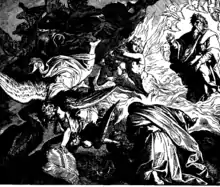جبل سيناء (مكان توراتي)
في الكتاب المقدس أو العهد القديم أو الكتاب العبري جبل سيناء هو الجبل الذي كلم الله عليه موسى وأوحى له بالوصايا العشر.[1] في سفر التثنية تقع بعض الأحداث على جبل حورب، يعتقد بعض الباحثين أن جبل حورب هو نفسه جبل سيناء.[2] ذُكر جبل سيناء في القرآن أيضًا باسم "طور سيناء" و"طور سينين".
لا يزال موضع جبل سيناء الموصوف في الكتاب المقدس محل نزاع، كانت ذروة النزاع في منتصف القرن التاسع عشر.[3] تصف نصوص الكتاب المقدس العبري التجلي الإلهي على جبل سيناء بمصطلحات قد تصف حرفياً الجبل بأنه بركان.[4]
يعد جبل سيناء من أقدس الأماكن في الديانة اليهودية والمسيحية والإسلام.[5][6]
جبل سيناء في الفن
موقع مجهول أو متخيل
 1723
1723 1895
1895.jpg.webp) الوحي الجماعي في جبل سيناء في رسم توضيحي لبطاقة الكتاب المقدس التي نشرتها شركة بروفيدنس ليثوغراف، 1907
الوحي الجماعي في جبل سيناء في رسم توضيحي لبطاقة الكتاب المقدس التي نشرتها شركة بروفيدنس ليثوغراف، 1907 تجلي الرب لإيليا على جبل حوريب، 1860، نقش خشبي بقلم يوليوس شنور فون كارلسفيلد
تجلي الرب لإيليا على جبل حوريب، 1860، نقش خشبي بقلم يوليوس شنور فون كارلسفيلد
جبل موسى
.jpg.webp) جبل سيناء، مخطوطة جورجية متأخرة من القرون الوسطى
جبل سيناء، مخطوطة جورجية متأخرة من القرون الوسطى 1719
1719.jpg.webp) القرن السادس عشر
القرن السادس عشر اليوناني
اليوناني
المراجع
- Exodus 19
- Coogan, Michael David. The Old Testament: A Historical and Literary Introduction to the Hebrew Scriptures. Oxford University Press, USA, 2017: pg. 108
- George Manginis, Pillar of Fire or Dust? Jabal Mūsā in the Nineteenth Century', Proceedings of the Multidisciplinary Conference on the Sinai Desert; "The years between the 1830s and the 1870s, which mark the highpoint of the Sinai controversy, witnessed the rise of European countries into worldwide economic and political prominence... The 1856 Treaty of Paris ensured better access for Europeans into Ottoman territory and casual visitors collected intelligence alongside antiquities... The peninsula was strategically situated on the sea route from the Mediterranean to India through the Suez Canal which opened to traffic in 1869, a few months after the conclusion of the Ordnance Survey" نسخة محفوظة 24 ديسمبر 2019 على موقع واي باك مشين.
- James K. Hoffmeier (2005). Ancient Israel in Sinai (ردمك 0198035403) p. 131. "Now that Rameses is known to be located at Qantir in the Sharkiya province of the east Delta, this means that Beke's proposed site of ... Hermann Gunkel, Hugo Gressman, Martin Noth and Jean Koenig. They all thought that the biblical descriptions of the theophany at Mt. Sinai described volcanic activity, and since there was no evidence of volcanoes in Sinai, that northern Arabia was the more likely."
- Sharīf, J.; Herklots, G. A. (1832). Qanoon-e-Islam: Or, The Customs of the Moosulmans of India; Comprising a Full and Exact Account of Their Various Rites and Ceremonies, from the Moment of Birth Till the Hour of Death. Parbury, Allen, and Company. مؤرشف من الأصل في 10 يونيو 2020.
koh-e-toor.
الوسيط|CitationClass=تم تجاهله (مساعدة) - Abbas, K. A. (1984). The World is My Village: A Novel with an Index. Ajanta Publications. مؤرشف من الأصل في 10 يوليو 2020. الوسيط
|CitationClass=تم تجاهله (مساعدة)
جبل سيناء في المشاريع الشقيقة
 صور وملفات صوتية من كومنز
صور وملفات صوتية من كومنز
- بوابة علم الآثار
- بوابة الشرق الأوسط القديم
- بوابة إسرائيل
- بوابة الأديان
- بوابة الإنجيل
- بوابة اليهودية
This article is issued from Wikipedia. The text is licensed under Creative Commons - Attribution - Sharealike. Additional terms may apply for the media files.